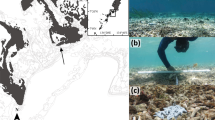Abstract
Native Hawaiian estuarine detritivores; the prawn Macrobrachium grandimanus, and the neritid gastropod Neritina vespertina, were maintained in flow-through microcosms with conditioned leaves from two riparian tree species, Hau (Hibiscus tiliaceus) and guava (Psidium guajava). Their ability to beak down leaf detritus was determined when alone and when they were together. In single-species treatments, N. vespertina processed leaves from both trees at higher rates than M. grandimanus, but in combined treatments, facilitation occurred when the substrate consisted of Hau leaves, and interference occurred when the substrate consisted of guava leaves. From this, we conclude that whether detritivore species are functionally redundant, facilitating or inhibiting in their processing of detritus depends not only on the detritivore species, but also on the species composition of the detritus food source.
Similar content being viewed by others
References
Aerts, R., 1997. Climate, leaf litter chemistry and leaf litter decomposition in terrestrial ecosystems: a triangular relationship. Oikos 79: 439–449.
Boling, Jr., R. H., E. D. Goodman, J. A. Van Sickle, J. O. Zimmer, K. W. Cummins, R. C. Petersen & S. R. Rice, 1975. Toward a model of detritus processing in a woodland stream. Ecology 56: 141–151.
Bond, W. J., 1993. Keystone species. In Schulze, E. D. & H. A. Mooney (eds), Biodiversity and Ecosystem Function. Springer-Verlag, Berlin: 237–253.
Coûteaux, M-M., P. Bottner & B. Berg, 1995. Litter decomposition, climate and litter quality. Trends Ecol. Evol. 10: 63–66.
Covich, A. P., M. A. Palmer & T. A. Crowl, 1999. The role of benthic invertebrate species in freshwater ecosystems. Bio-Science 49: 119–127.
Cuffney, T. F., J. B. Wallace & G. J. Lugthart, 1990. Experimental evidence quantifying the role of benthic invertebrates in organic matter dynamics of headwater streams. Freshwat. Biol. 23: 281–299.
Cummins, K. W., 1974. Structure and function of stream ecosystems. BioScience 24: 631–641.
Day, J. W, Jr., C. A. S. Hall, W. M. Kemp & A. Yáñez-Arancibia, 1989. Estuarine Ecology. John Wiley & Sons, New York.
Ehrlich, P. R. & A. H. Ehrlich, 1981. Extinction. The Causes and Consequences of the Disappearance of Species. Random House, New York.
Ehrlich, P. R. & B. Walker, 1998. Rivets and redundancy. Bio-Science 48: 387.
Finlay, B. J., S. C. Mabery & J. I. Cooper, 1997. Microbial diversity and ecosystem function. Oikos 80: 209–213.
Jones, C. G. & J. H. Lawton, 1995. Linking Species and Ecosystems. Chapman & Hall, New York.
Heard, S. B. & J. S. Richardson, 1995. Shredder-collector facilitation in stream detrital food webs: is there enough evidence? Oikos 72: 359–366.
Lawton, J. H., 1994. What do species do in ecosystems? Oikos 71: 367–374.
Lawton, J. H. & V. K. Brown, 1993. Redundancy in ecosystems. In Schulze, E. D. & H. A. Mooney (eds), Biodiversity and Ecosystem Function. Springer-Verlag, Berlin: 255–270.
Minshall, G. W., K. W. Cummins, R. C. Peterson, C. E. Cushing, D. A. Bruns, J. R. Sedell & R. L. Vannote, 1985. Development of stream ecosystem theory. Can. J. Fish. aquat. Sci. 42: 1045–1055.
Naeem, S., 1998. Species redundancy and ecosystem reliability. Cons. Biol. 12: 39–45.
Odum, E. P., 1980. The status of three ecosystem hypotheses regarding salt marsh estuaries: tidal subsidy, outwelling and detrital based food chains. In Kennedy, V, (ed.), Estuarine Perspectives. Academic Press, New York: 485–495.
Odum, W. E., 1984. Dual-gradient concept of detritus transport and processing in estuaries. Bull. Mar. Sci. 35: 510–521.
Peckarsky, B. L., S. D. Cooper & A. R. McIntosh, 1997. Extrapolating from individual behavior to populations and communities in streams. J. n. am. Benthol. Soc. 16: 375–390.
Robinson, J. V. & J. E. Dickerson, 1987. Does invasion sequence affect community structure? Ecology 68: 587–595.
Tank, J. L., J. R. Webster & E. F. Benfield, 1993. Microbial respiration on decaying leaves and sticks in a southern Appalachian stream. J. n. am. Benthol. Society 12: 394–405.
Vannote, R. L., G. W. Minshall, K. W. Cummins, J. R. Sedell & C. E. Cushing, 1980. The river continuum concept. Can. J. Fish. aquat. Sci. 37: 130–137.
Wagner, W. W., D. R. Herbst & S. H. Sohmer, 1990. Manual of the Flowering Plants of Hawaii. Bishop Museum Special Publication 83. B. P. Bishop Museum Press.
Wallace, J. B., S. L. Eggert, J. L. Meyer & J. R. Webster, 1997. Multiple trophic levels of a forest stream linked to terrestrial litter inputs. Science 277: 102–104.
Wardle, D. A., K. I. Bonner & K. S. Nicholson, 1997. Biodiversity and plant litter: experimental evidence which does not support the view that enhanced species richness improves ecosystem function. Oikos 79: 247–258.
Rights and permissions
About this article
Cite this article
Chong, C.T., Larned, S.T., Covich, A.P. et al. Species interactions between estuarine detritivores: inhibition or facilitation?. Hydrobiologia 434, 11–16 (2000). https://doi.org/10.1023/A:1004098425855
Issue Date:
DOI: https://doi.org/10.1023/A:1004098425855




